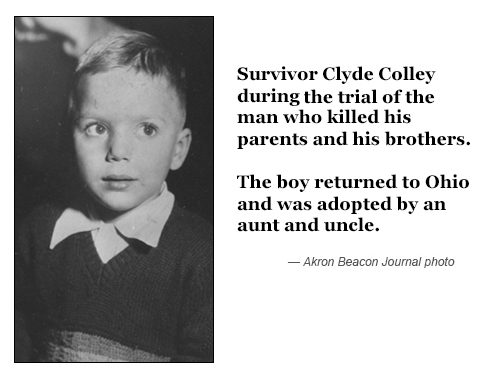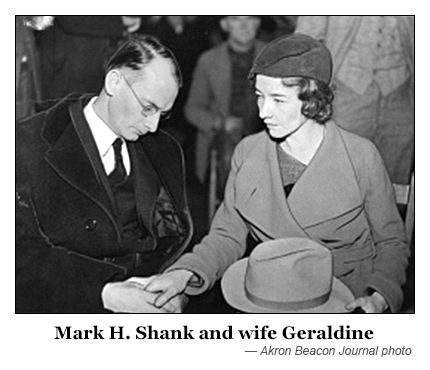 |
During the 1920s, Akron attorney Mark H. Shank seemed to have a successful career. He was president of the local Kiwanis Club and justice of the peace in Kenmore, now a part of the city, but then a separate village along Akron's southwest border.
Along came the Depression, and Shanks lost almost all of the $70,000 he had tucked away in a bank that collapsed. Shanks became a changed man, a desperate man, and perhaps a crazy man.
His deteriorating mental state led him into a legal tangle that prompted him to commit murder in one of the 1933's most unbelievable and tragic incidents.
Much of what I know about Mark H. Shank comes from an August 11, 2013 article by Mark J. Price in the Akron Beacon Journal.
But what drew my attention to Shank in the first place were these two news stories from 1933: |
Syracuse Journal, August 16, 1933
HOT SPRINGS, Arkansas (INS) — The lisped words of a three-year-old child provided the evidence today which police announced enabled them to solve the fatal poisoning of four members of a family of five, described as the worst poison case in the history of the state.
Mark H. Shank, 41, Akron, Ohio, attorney, has signed a written confession admitting the poisoning of Mr. and Mrs, Alvin Colley, 34, and their two children, Clement, 11, and Clarence, 7, announced Chief of Police Joe Wakelin and officials of Saline County.
“Shank put som’fin in jug,” was what little Clyde Colley, a third child, told them. Clyde is recovering from the strychnine which police say killed his parents and brothers.
The four members of the Colley family, two of them dead and two others dying, were found in their car near Malvern, Arkansas, after it had run off the road with the lifeless Colley at the wheel. Colley and the older boy, Clement, were dead, and the mother and second son, Clarence, 7, were racked with convulsions when found.
Shank, police reported, had been seen running from the Colley car and was picked up later in a nearby woods.
The attorney was brought to the local jail for protection when an angry crowd began to gather at Malvern.
Officers discovered a box containing strychnine, which they say Shank admitted purchasing in Kenmore, Ohio, and which they declare he used to kill the Colleys and their children. The contents of a bottle found in the Colley’s car were sent to a chemist for analysis.
The theory that the Colleys were poisoned “because they knew too much” was advanced by local officials. They told of finding a letter on Mrs. Colley, which they say was written by Shank and in which he is said to have offered the Colleys a fortune “to keep their mouths shut.”
The Colleys had been living at a Malvern rooming house.
The partial confession which, officials say, Shank signed, read: “I am guilty of murder of four persons by poisoning and I only ask of you officers that you ask of the court that it show me all the mercy possible.”
Officers said the box of poison was found in Shank’s pockets.
The “jug” or bottle, in which little Clyde told officers he saw Shank “put som’fin,” contained poisoned grape juice, officers said. |
|
The FBI defines "mass murder" as the killing of four or more people in one non-stop event. The term wasn't yet in use, nor were such terms as "serial killer" or "family annihilator," though there were several people who could have been so labeled throughout our history. "Family annihilators" were particularly active during the depression because of the many fathers and mothers who were overwhelmed by their hardships. |
Syracuse Journal, August 17, 1933
LITTLE ROCK, Arkansas (INS) — Mark H. Shank, Akron, Ohio, attorney and confessed poisoner of four, was rushed to the state penitentiary here under heavy guard. Shank, accompanied by a large police escort, was first taken from Hot Springs to Benton, county seat of Saline County, for preliminary hearing, which he waived.
District Attorney Millard Halbert said today he would ask the death penalty for Shank.
Halbert ignored Shank’s pleas for leniency as he prepared to take the attorney to Benton for the preliminary hearing today on the charge of murder. The prosecutor said he plans to send Shank to the state penitentiary at Little Rock for safe keeping until the trial.
The dead victims of the poison plot were Alvin Colley, his wife, Ethel, 34, and their two small sons, Clarence, 7, and Clement, 10.
Shank said he came here from Akron Sunday to poison Colley to escape the blackmail threats of an unnamed woman who demanded $400 for her silence.
He had planned to get rid of only Colley, the attorney said, and had given “no thought at all” to killing the rest of the family.
Shank explained that the unnamed woman had threatened to implicate him in the theft from the prosecutor’s office in Wooster, Ohio, of papers in a forgery case against one of his clients. Colley was implicated in the robbery and Shank said the man had been “running around” with the woman.
The attorney said that while Mrs. Colley was preparing lunch he placed strychnine in five cups containing grape juice.
One child, Clyde, 3, survived. |
|
 |
Alvin Colley was an Akron truck driver when he met Shank, who represented Colley in a personal injury lawsuit. Perhaps as part of a quid pro quo arrangement, Shank asked Colley to steal evidence for the prosecutor's office in Wooster in order to clear another of Shank's clients.
Apparently, the married Colley had a girl friend on the side. At least, that was Shank's theory when he received a blackmail letter from a woman who knew about the Wooster break-in and wanted $400 to remain quiet.
Shank advised Colley to drive his family to Arkansas to lay low for a while, and then Shank bought a vial of strychnine — to get rid of some rats, he told the clerk at the Kenmore drug store — and headed south to kill Colley.
However, when Shank suggested he join the family for a picnic outing, this put all of the Colleys at risk. It also led to Shank's quick arrest because the lawyer apparently went to the picnic as a passenger in the Colley automobile, perhaps thinking he'd drive it back to Hot Springs to where he'd left his vehicle, leaving five bodies around a picnic blanket in a field off U. S. highway 67, several miles to the east.
But Colley, feeling the effects of the poison but realizing his family needed medical intention, tried to drive them to a hospital. Shank got into the car despite knowing there was a dying man behind the wheel.
Mark Price's 2013 article describes what happened next: |
A fast-moving automobile swerved erratically on U.S. 67 in Arkansas. Detective Chief Herbert Akers of Hot Springs was cruising behind the car when it missed a curve and rolled into a ditch near Malvern, Ark.
To the officer’s surprise, a passenger leaped out of the moving car. Akers pulled over, drew his gun and started to chase the man, but went back to the crash scene, where he made a horrifying discovery.
A man, woman and three young boys were sprawled inside, convulsing and gasping for breath. Ambulances rushed the family to a hospital, but doctors could only revive one child after pumping his stomach. Everyone else died.
A search party used bloodhounds to track the mysterious man who fled the vehicle. About an hour later, the dogs found him in a thicket about 5 miles from the crash scene |
|
After being interrogated for more than five hours, Shank confessed, though he'd later claim the confession had been beaten out of him. However, the surviving youngster's statement that the lawyer had put something in the jug of grape juice — which didn't square with Shank's story that he had put the poison in five cups — and the evidence given by the Kenmore clerk who had sold the poison to the lawyer left no doubt Shank would be convicted.
And so he pleaded not guilty by reason of insanity. Throughout the five-day trial Shank apparently behaved like a crazy man, making strange noises while testimony was given, but the jury, after deliberating for nine hours, pronounced the defendant guilty. Shank was sentenced to die, and after a series of delays postponed the execution for 13 months, the Akron lawyer was electrocuted on March 8, 1935 at the Tucker Prison Farm.
Geraldine Shank, the murderer's wife, helped pay for her husband's defense by selling her diamond wedding ring. She also offered one of my favorite alibis. Her husband couldn't have killed those people, she said, because "He loathed picnics." |
 |
Mark J. Price is author of "The Rest Is History: True Tales From Akron’s Vibrant Past," a book from the University of Akron Press.
|
| |
| HOME • CONTACT |
| |
|



